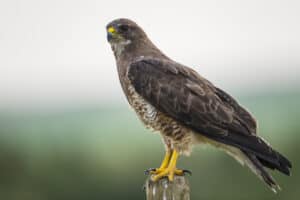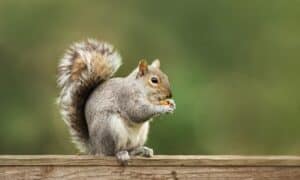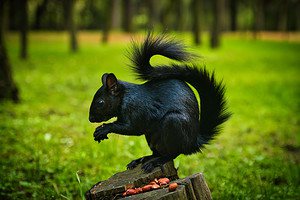Many types of tree squirrels are found worldwide, living in various habitats including deserts, rainforests, forests, and cities. They share many common characteristics, and are generally small (with a few exceptions) and have lightweight, slender bodies. They are known for their beautiful bushy tails and big eyes. Squirrels have many different types of coats across their 285 species and 58 genera, but on average, their coats are thick and soft.
Squirrels are herbivores, feeding on nuts and seeds, although they have been known to eat insects or small vertebrates if that is all that is available. Some squirrels eat mushrooms, garden vegetables, agricultural crops, flowers, tree buds, and just about anything else they can get their hands on.
Squirrels live 5-10 years in the wild and are important to the ecosystem. They distribute plants by moving nuts and seeds around their habitats and replanting them. Squirrels expand forests and increase the variety of trees growing in them. There are over 100 types of tree squirrels. Read on to learn more about these fascinating rodents.
American Red Squirrel (Tamiasciurus hudsonicus)
The American red squirrel is also called the pine squirrel, Hudson’s bay squirrel, and chickaree. American reds make their homes in pine trees, their diet consisting primarily of pine cones
The American red can be found in most areas of North America, except on the West Coast.
The red squirrel is smaller than some other North American squirrels, reaching a maximum length of 14 inches. This measurement includes the tail! They have soft reddish-brown coats and a white undersides.
Red squirrels eat seeds but are not particular, eating whatever is available. American reds store their excess food in a centralized cache, from which they will eat throughout the winter.
American red squirrels’ mating ritual consists of dashing out of their territory to attract a mate, and chasing them around. Their nests are made of grass packed into the cavities of trees. Red squirrels gestate for 31-35 days, delivering one to five kits per litter. Kits are born weighing 0.3 ounces, reaching their adult weight of 5-8 ounces by the time they are 4 months old.
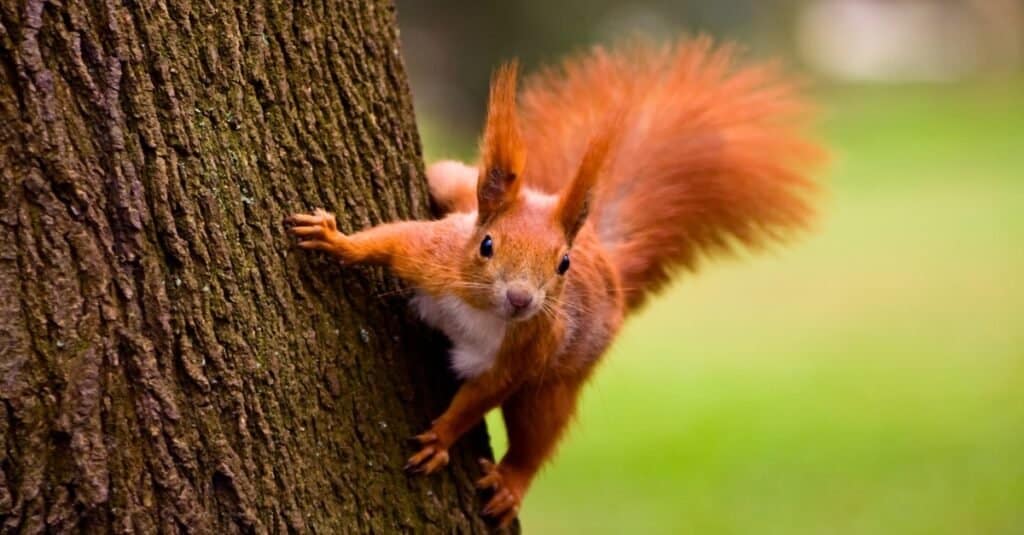
American red squirrels store their excess food in a centralized cache, from which they will eat throughout the winter.
©seawhisper/Shutterstock.com
Eastern Gray Squirrel (Sciurus carolinensis)
The Eastern gray squirrel is native to Eastern North America, but has been widely introduced to other parts of the world. They have adapted well in Europe where they are considered an invasive species.
Gray squirrels’ coats are gray, flecked with brown. They have white underbellies and thick, bushy tails. Grays are between 16 and 21 inches long, including their tails, and weigh between 14-21 ounces.
Eastern grays eat a variety of foods, including tree bark, flowers, acorns, walnuts, seeds, mushrooms, truffles, insects, and even garden vegetables. Gray squirrels are adaptable, living anywhere there is a reliable food source, including urban neighborhoods, where you may have seen them raiding bird feeders!
The Eastern gray hoards food for the winter in many small caches spread across its territory. An excellent memory, paired with a fine sense of smell, allows the squirrel to find and retrieve these stores.
Eastern grays are also clever enough to pretend to bury food when they feel they are being watched. Instead, the squirrel will hide the food in its cheeks before running away.
About a week before they are ready to mate, female Eastern grays begin attracting males from as far as 34 miles away. They build their nests out of moss, grass, and feathers in hollow tree trunks or on top of large tree branches. Eastern grays bear one to four kits per litter, weighing less than an ounce, but attaining full adult size in eight months.
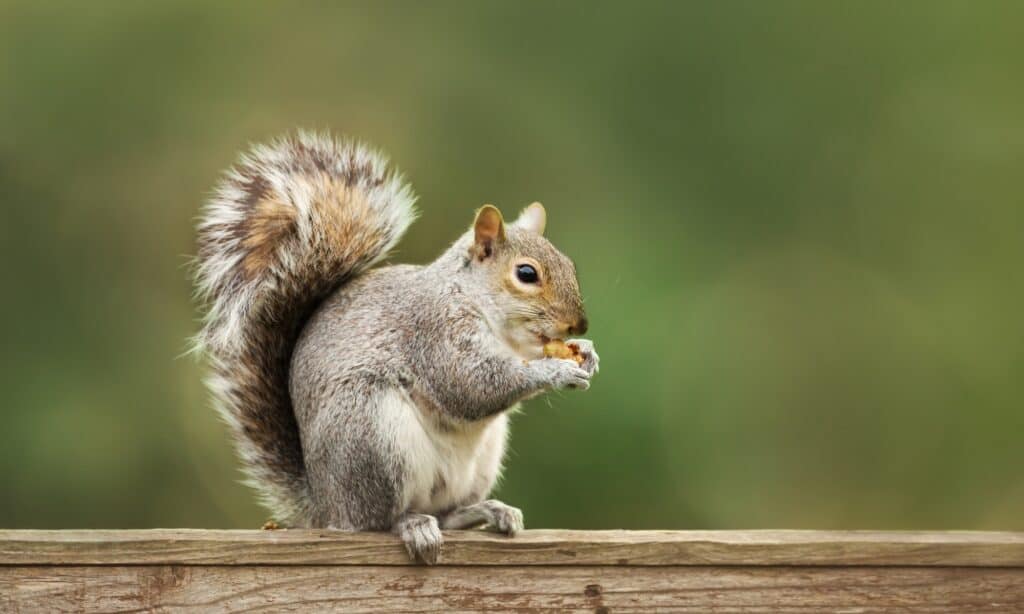
The Eastern gray squirrel hoards food for the winter in many small caches spread across its territory.
©iStock.com/Dgwildlife
Western Gray Squirrel (Sciurus griseus)
The Western gray squirrel is another animal with many names. It is called the silver-gray squirrel, California gray squirrel, and banner-tail squirrel, to name a few. These squirrels live along the West Coast of the United States and Mexico.
Western grays are one of the larger species of tree squirrels. Ranging from 17 to 24 inches long, including the tail, they weigh a relatively hefty 2.2 pounds. Western grays have multi-colored coats, which act as camouflage. They are silvery gray on top with a white underbelly, a silver and gray s-shaped tail. This squirrel molts in the spring, using its hair to build a furry nest for its young.
Western grays live in forests. They are most active during the day, feeding on seeds, nuts, acorns, berries, insects, and mushrooms. The western grays, like their Eastern cousins, have multiple small caches of food spread throughout their territory. Western gray squirrels spread their tails in a fan-like fashion, covering their bodies when burying their food.
Western grays build nests using their own shed fur, moss, lichen, sticks, leaves, and grass. In the winter, they make large covered nests up to 18 inches in diameter. Mating begins in the late winter or very early spring. Western grays gestate for 44 days, typically resulting in a litter one to five kits. The babies stay in the nest for up to six months, which is a long time for squirrels. Western grays reach maturity at 10 months, a bit later than other squirrels as well.
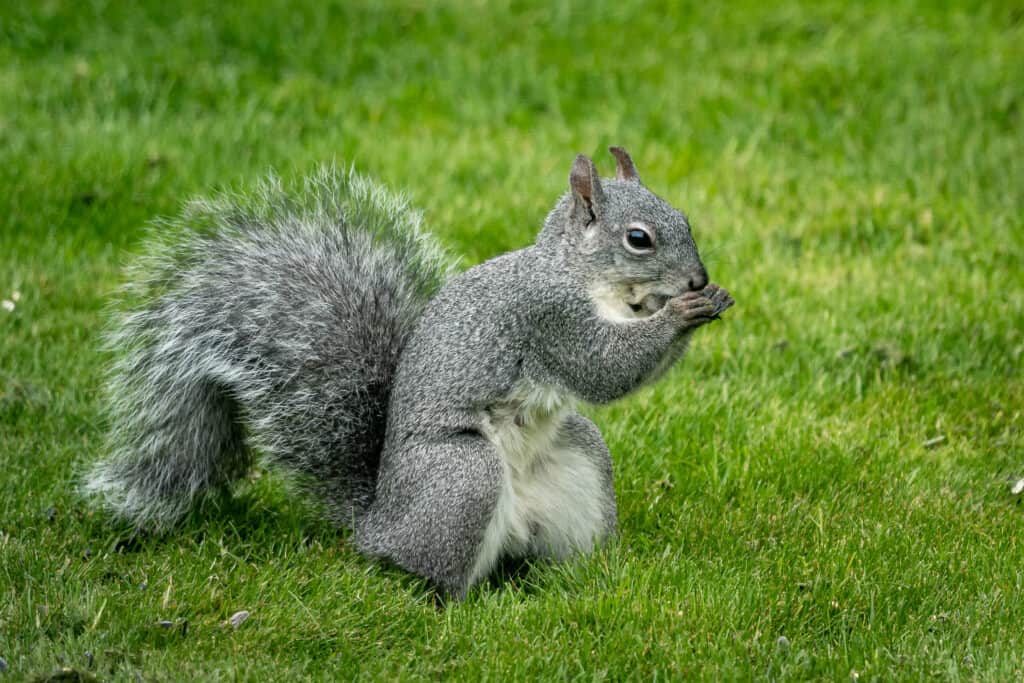
Western grays reach maturity at 10 months, which is a bit later than other squirrels.
©d murk photographs/Shutterstock.com
Indian Giant Squirrel (Ratufa indica)
The Indian giant squirrel is also called the Malabar giant squirrel. It can be found in India, living in forests at altitudes between 590-7550 feet. They typically nest in trees taller than 30 feet.
The Indian giant, as its name implies, is on the larger side, reaching lengths of up to one and a half feet, with an equally long tail, for a total length of over three feet! They can weigh as much as four and a half pounds.
Indian giants have beautiful, multi-toned coats that are a mix of black, tan, rust, and brown. Their undersides are usually a light brown or cream color. There are many subspecies with similar markings and mixes of colors.
The Indian giant lives in the upper canopy of the forest. It likes tall trees and prefers to travel across the forest by jumping from tree to tree. Indian giants can jump up to 20 feet! They are crepuscular animals, meaning that they are most active during the early morning and early evening. Indian giants eat fruit, nuts, tree bark, bird eggs, insects, and flowers. Their seed-spreading activities play an important role in the growth of the forest.
Indian giants build large round nests out of twigs and leaves. They build their nests on the higher, lighter, thinner branches, which keeps heavier predators at bay. The Indian giant has a gestation period of 84 days, with litters of one to three kits, weighing 2.6 ounces each.
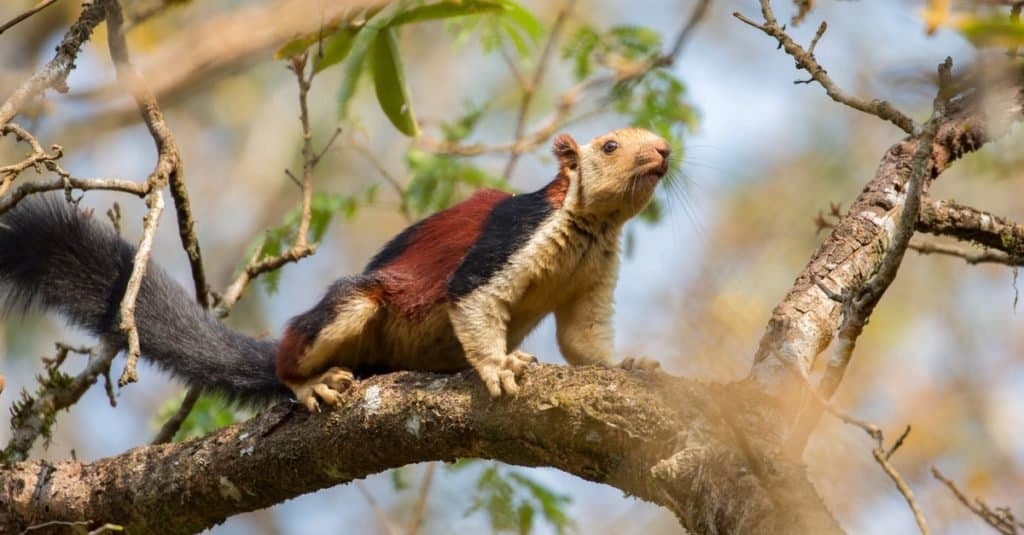
The Indian giant squirrel lives in the upper canopy of the forest.
©Manu M Nair/Shutterstock.com
Fox Squirrel (Sciurus niger)
Fox squirrels, also called Eastern fox squirrels, are tree squirrels native to North America. They live in forests and residential areas with many trees, particularly pecan, pine, oak, hickory, and walnut. They prefer sparse undergrowth and are rarely found in forests with dense underbrush.
A fox squirrel, including its tail, is about two and a half feet long. Their coats are various shades of brown and black with a red-brown underside. They have long claws which help them climb fast.
Their diet is varied, consisting of whatever is available in their regions, including seeds, nuts, mushrooms, insects, buds, bird eggs, and fruit. They are good at foraging food from human areas, including agricultural crops. Fox squirrels are diurnal, foraging during the day, spending much of their time storing up food for the winter.
Fox squirrels build their nests out of leaves, which they place in branch forks or tree cavities. The nests can be quite large, reaching up to 21 inches in diameter.
Fox squirrels start breeding in late winter and are pregnant for 45 days. They have between one and three kits per litter, with each kit weighing a scant 1/2 ounce.
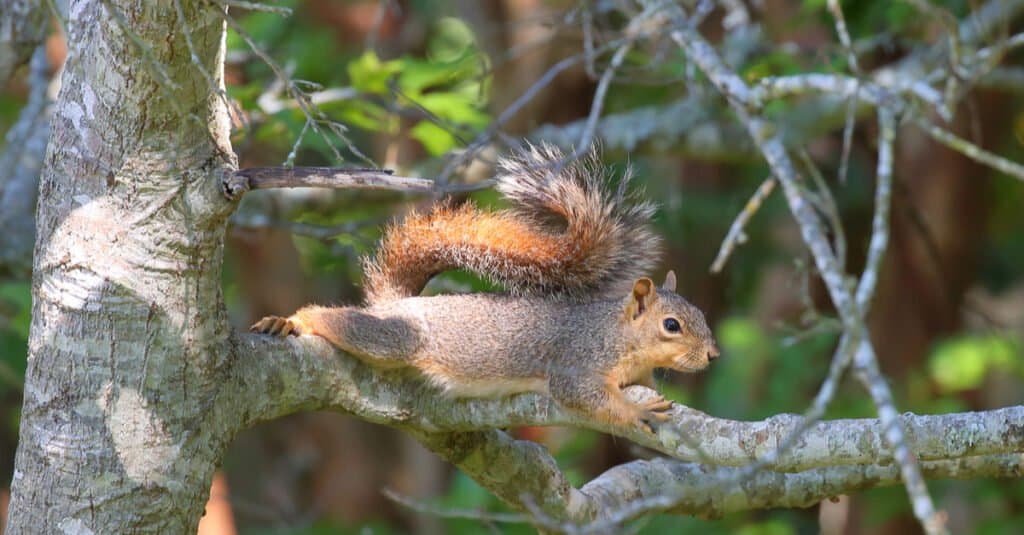
A fox squirrel, including its tail, is about two and a half feet long.
©JustPixs/Shutterstock.com
INCREDIBLE SQUIRREL FACTS
- Squirrels can be found on every continent except Antarctica.
- There are many types of squirrels. The squirrel family includes tree squirrels, ground squirrels (like chipmunks and prairie dogs), and flying squirrels.
- Squirrels spread seeds and nuts across the forest and are crucial members of the ecosystem.
- Squirrels can find the food they bury, even if it is buried under the snow.
- A squirrel’s front teeth never stop growing. That is why they like to gnaw and chew, helping keep their teeth trimmed to the perfect length.
- Some squirrels are less than an inch long when born.
- The squirrel family includes chipmunks, marmots, prairie dogs, and ground squirrels.
- Squirrels are great communicators, using a variety of barks, chatters, and screams to get their message across. They even purr!
- A squirrel’s tail has many purposes. They use it to keep warm, to keep their balance, to provide shade, and to communicate emotion. Some squirrels use their tail as a parachute.
- Squirrels can hoard up to 10,000 nuts in a year.
- Squirrels have been known to foster orphaned baby squirrels and raise them as their own.
- Squirrels have a peripheral vision that is equally acute to their frontal focal vision.
NEXT UP…
- Ground Squirrel Vs Tree Squirrel: What Are the Differences?
- Are Weasels Rodents?
- Are Squirrels Rodents?
The photo featured at the top of this post is © Andrew Swinbank/Shutterstock.com
Thank you for reading! Have some feedback for us? Contact the AZ Animals editorial team.




